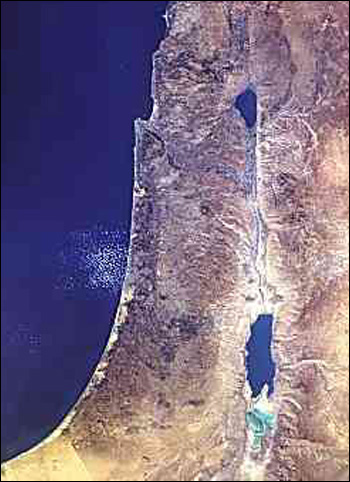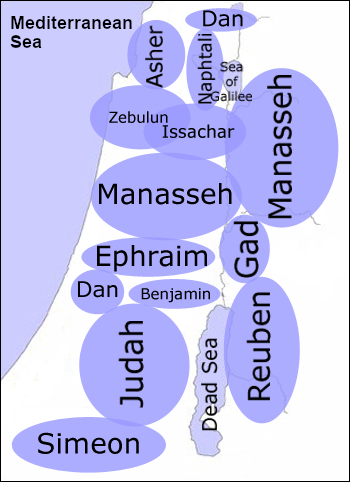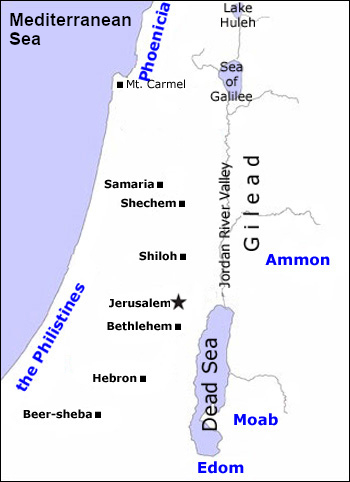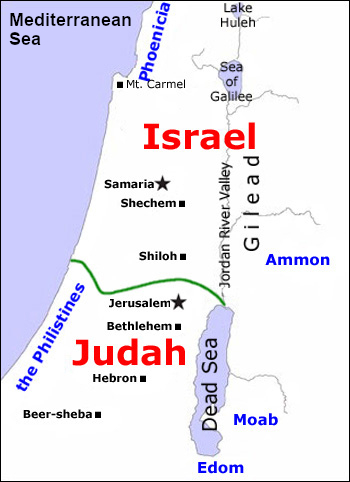Reading Old Testament Maps

Physical Features
There are two main differences between what we can see today from a satellite hovering over the east end of the Mediterranean Sea and what would have been seen thirty-five hundred years ago. First, Lake Huleh north of the sea of Galilee is nearly gone. Also called the waters of Merom, Lake Huleh has been steadily silting up for millennia. By modern times, it was mostly a swamp, and from 1950 to 1958 over 12,000 acres of it were drained to become farmland. The second thing we would notice is that the Dead Sea has shrunk. It is literally drying up and is probably half the size it was in Old Testament times.

The Tribes of Israel
Here are the approximate allotments of the tribes of Israel made by Joshua at the time of the conquest. (Joshua 13-21) Notice that the tribe of Manasseh received a double portion, and the tribe of Levi received no territory only cities. Do you know why?
You may note that the tribe of Dan is in two locations. They took over the northern location when they lost the southern location (their original allotment) in battle. (Joshua 19:40-48, Judges 18)
Take the tribes of Israel map quiz.

The United Kingdom
Note the territories of the Phoenicians, the Philistines, the Ammonites, the Moabites, and the Edomites.
Note Samaria the chief city of the northern tribes.
Note Shechem an important city for Abraham and Jacob.
Note Shiloh where the Tabernacle stood for many years.
Note Jerusalem which David made his capital.
Note Bethlehem where David was born.
Note Hebron where Abraham and Sarah are buried.
Take the United Kingdom map quiz.

The Two Kingdoms
After the death of King Solomon, the tribes in the north separated from the tribes in the South. The northern kingdom kept the name Israel, and the southern kingdom took the name of its largest tribe Judah. Calling the Children of Israel "Jews" today reflects back to the name of the kingdom of Judah.
Israel would be conquered in 722 B.C. by the Assyrians. The inhabitants would be scattered throughout the world by the Assyrians and would come to be known as the lost tribes of Israel.
Judah would continue as a kingdom until 586 B.C. when it would in turn be conquered by Babylon, and all the noble families and people with any education were forced to go into exile most of them to the city of Babylon.
After the Jews had spent seventy years in exile the Babylonians were conquered by the Persians and the Persian king allowed many of the refugees from Judah to return and rebuild Jerusalem. The books of Ezra and Nehemiah record this return and rebuilding.
Judah and the rest of the Persian Empire would later be conquered by Alexander the Great. When Alexander died in 323 B.C., his empire was divided among his generals. Judah was eventually controlled by the Seleucid Empire, the eastern segment of Alexander's territories (I Maccabees 1-8).
The Jewish rebellion that overthew the Seleucid Empire (167-160 B.C.) is told in the books of the Maccabees.
In 63-64 B.C., Judea (previously called Judah), along with Samaria and Galilee, came under Roman rule when Pompey intervened in a Jewish dynastic dispute. He was welcomed into Jerusalem by Hyrcanus II, a descendant of the Maccabean family which drove the Seleucid Empire's armies out of Israel generations before and had been allies with the Romans rather than their subjects. After several generations of occupation, The Jewish people revolted against the Romans, and in retaliation, the Romans destroyed the Temple in 70 A.D.